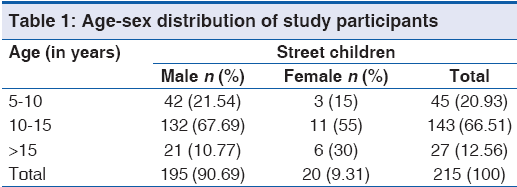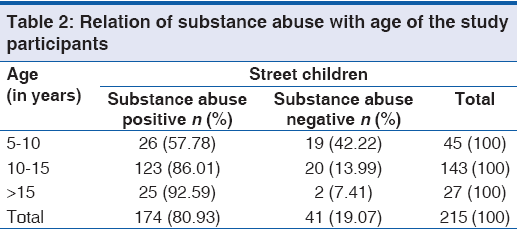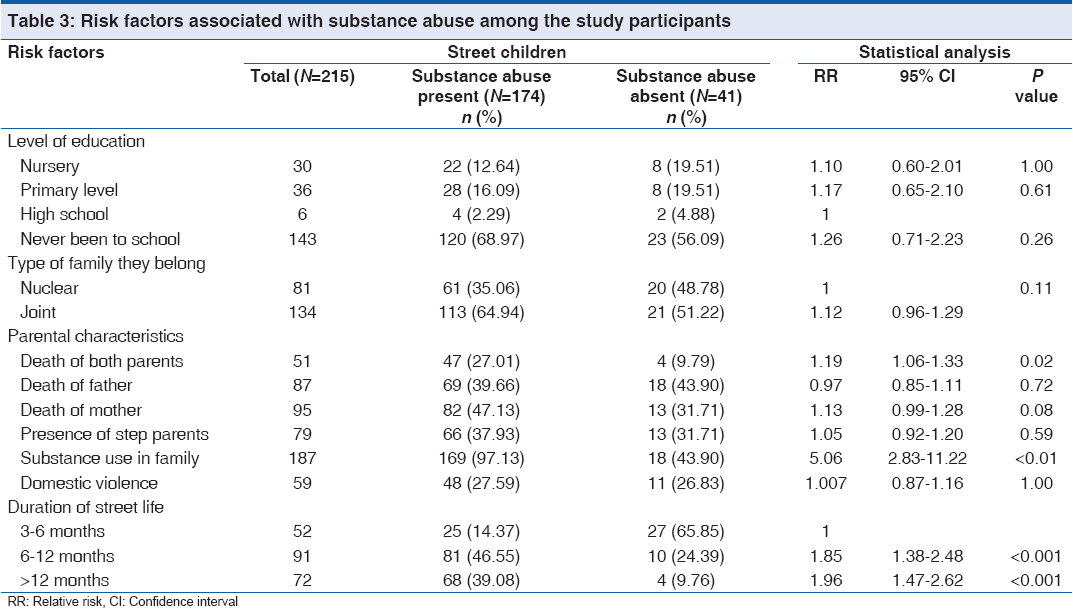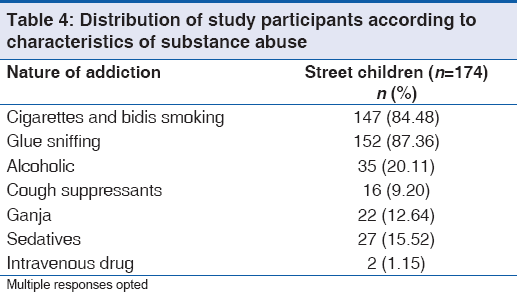Substance Abuse amongst the Street‑children in Guwahati City, Assam
- *Corresponding Author:
- Dr. Sumit Kar
Department of Community Medicine, Sikkim-Manipal Institute of Medical Sciences, 5th Mile Tadong, Gangtok - 737 102, Sikkim, India.
E-mail: sumit300176@gmail.com
Abstract
Background: The nature of continuous exposure to the street and its associated life‑styles make street children vulnerable to the use of psychoactive substances. Aims: The aim of the present study is to study some social factors of street children in Guwahati city and to ascertain the substance use behavior of the street children. Subjects and Methods: A population based cross‑sectional study conducted during September 2008 to August 2009 among 215 street children between the ages of 5 and 18 years of Guwahati City Assam. The main outcome measures were substance use and its related risk factors prevalent among street children. The data collected were analyzed in Microsoft Office and percentages and Chi‑square tests were used to analyze the variables. Results: Around 174/215 (80.9%) of study participants were substance abusers. It is noteworthy that as the age increases substance use was more common when compared to younger age group. The risk of substance abuse was 1.26 times relatively higher among those who had never been to school and 1.12 times more common in those from a joint family when compared to others. However the correlations were not found to be statistically significant. Substance abuse was 1.19 times more common in case of deaths of both parents and the association was found to be statistically significant (P = 0.02). Presence of step parents and substance use in the family was seen to be a risk factor for substance abuse and the association was highly significant (P < 0.001). The association of substance abuse with duration of street life was found to be highly significant. Majority of the substance users 152/174 (87.4%) were in the habit of sniffing glue and this was followed by smoking 147/174 (84.5%). Conclusion: Substance abuse is an important concern affecting street children. Street and its associated life‑styles make street children vulnerable to the use of psychoactive substances. Non‑ government organizations and Government should come forward to curb this problem and save millions of vulnerable lives.
Keywords
Asia, Street children, Substance abuse
Introduction
Rapid urbanization and large scale migration of people to the cities has resulted in the emergence of street children. The most common definition of a street child or youth is “any girl or boy who has not reached adulthood, for whom the street (in the broadest sense of the word, including unoccupied dwellings, wasteland, etc.) has become her or his habitual abode and/or source of livelihood and who is inadequately protected, supervised or directed by responsible adults.”[1]
In 1981, the then advisor to the United Nations Children’s Fund (UNICEF) in New York, in issues related to abandoned children and those without a family, Peter Tacon, brought to public light what was the first estimate of street children in the world and pioneered the term street child. UNICEF (1986) made further distinction among street children.
Millions of children in the world are forced to seek survival on the streets of cities.[2] They work and live alone without adequate food, shelter, education, affection and social security, leaving them extremely vulnerable with many of their physical, mental and social needs unfulfilled.[3] In turn, these marginalized children fall into patterns of drug use in order to cope with their adverse circumstances and to survive on the streets.[4] The non-medical use of chemical substances in order to achieve alterations in psychological functioning has been termed as substance use.[5] The nature of continuous exposure to the street and its associated life-styles make street children vulnerable to the use of psychoactive substances. Street children’s drug use often commences with alcohol, tobacco and inhalants which are legal and easily accessible in most countries. World Health Organization estimates that globally, 25-90% of street children indulge in substance use.[6] According to UNICEF, there are more than 500,000 street children in India who live and work in inhuman conditions and are at high risk of substance use.[7,8] This number is a drastic underestimation. The Indian embassy estimated 314,700 street children in cities such as Mumbai, Kolkata, Chennai, Kanpur, Bangalore and around 1,000,000 alone in Delhi.[9]
Taking these facts into consideration and realizing the need for community based data, the present study on social conditions and substance abuse of street children in Guwahati city, Assam, was undertaken with the following objectives:+
1. To study the socio-demographic profile of street children in Guwahati city
2. To ascertain the substance use behavior of the street children
3. To find out the risk factors of substance use among the street children.
Subjects and Methods
A population based cross-sectional study conducted during September 2008 to August 2009 among 215 street children between the ages of 5 and 18 years of Guwahati city, Assam.
Due to the inconsistent nature of their whereabouts and the difficulty in locating them, the children in the study sample were selected from in and around the main commercial centers of the city, where there were maximum congregation of street children.
The following exclusion criteria were employed:
• Participants who had spent <3 months in the streets
• Those, having behavioral disturbances, cognitive impairment (difficulty understanding questions) and auditory or verbal dysfunction (difficulty in communicating)
• Children in a state of severe drug intoxication, aggressive behavior.
The main outcome measures were substance use and its related risk factors prevalent among street children. The data collection tool was an interview schedule that was developed at the institute with the assistance from the faculty members and other experts of Department of Community Medicine, Guwahati Medical College. Detailed information regarding socio-demographic characteristics, duration of street life, substance abuse, was collected using this structured schedule. By initial translation, back-translation, re-translation followed by the pilot study, the questionnaire was custom-made for the study.
Ethical clearance/consent
Institutional ethical committee of Gauhati Medical College approved the study. The investigator made a detailed presentation to the Institutional Ethics Committee following which they gave the ethical clearance to go ahead with the study.
The street children are mostly from poor families who have migrated from the rural areas of Assam and from other neighboring States. Initially, these children came with their families or sometimes alone in search of a livelihood in the biggest city in the North Eastern part of India.
In course of time, due to various reasons that came out in this study, these children adopted a life in the streets of Guwahati. Once in the street, they hardly remained in contact with their parents, as the street became their home. They also formed groups in the street, which became a sort of family for them.
When the investigator tried to enquire about the whereabouts of their parents, majority of the street children replied that they were not in contact with their parents/families. Few mentioned the address of their parents but the investigator could not locate them at the given address. These happened as these poor people change their dwelling place very frequently and the neighbors do not have any idea where they have relocated.
As it was difficult to get access to the street children, non-governmental organization (NGO) workers and street leaders were motivated and mobilized. The street children usually move in groups. There is a hierarchy in the group with usually the oldest child being the decision maker. So, initially the investigator explained the purpose of the study to the whole group and then the children in the group discussed amongst themselves before giving their written consent. Also, as majority of the children could be accessed through the NGOs and other street leaders, so this NGO members and street leaders were briefed in detail about the purpose of the study. As these NGO members and street leaders enjoy the trust of the children, so they also played a key role in explaining the purpose of the study to the street children and getting their consent and were ensured strict confidentiality. The thumb impression of the children was taken on the consent form after explaining to them the nature and purpose of the study. They were given the option not to participate in the study if they wanted.
The principal investigator collected the data using the interview technique. At the end of the study period, the schedules were edited to check for those that were full of unanswered questions. At the end of this exercise, 215 schedules were taken up for analysis.
Statistical analysis
The data collected were thoroughly screened and entered into MS-Excel spreadsheets and analysis was carried out. The procedures involved were transcription, preliminary data inspection and interpretation. The statistical analyses were done using In graph Pad software Inc.5755 oberlin Drive San diego, California. Percentages and Chi-square tests were used in this study to analyze the variables.
Results
Majority (66.5% ie. 143/215) of the study participants were in the age group of 10-15 years, followed by 5-10 years (20.9% i.e., 45/215) and more than 15 years (12.7% i.e., 27/215). Maximum numbers of respondents were males (90.7% i.e., 195/215), while only 9.3% (25/215) were females [Table 1].

Around 80.9% (174/215) of study participants were substance abusers. Considering the age distribution as a risk of substance use, it was found that amongst the younger group, substance use was seen in 57.8% (26/45) of participants. Similarly, amongst 10-15 years, 86% (123/143) were substance users while among senior sections 92.6% (25/27) were substance users. It is noteworthy that as the age increases substance use was more common as compared to younger age group [Table 2].

Majority of the study participants (66.5% i.e., 143/215) had never gone to school, followed by education level up to primary, nursery and high school respectively. The risk of substance abuse was 1.26 times relatively higher in those who had never been to school, followed by 1.17 times higher risk in those who have completed the primary level and 1.10 times more in those who had just studied up to nursery considering high school as a standard. However the correlation between substance abuse and educational status was not found to be statistically significant.
In terms of family background, substance abuse was 1.12 times more common in those from a joint family, but the association was statistically not significant. Deaths of both parents were reported by 27% (47/174) of street children who were substance abusers as compared to 9.8% (4/41) of non-users. Substance abuse was 1.19 times more common in case of deaths of both parents and the association was found to be statistically significant (P = 0.02). Death of the father was reported by 39.7% (69/174) of those with substance abuse while death of mother was seen in 47.1% (82/174) cases. Maternal death was found to be a risk factor for substance use with a relative risk of 1.13. However, the association was statistically insignificant. Presence of step parents was seen to be a risk factor for substance abuse. Substance use in family was found to highly associated with substance abuse among the street children with a relative risk of 5.06 and P < 0.001 Presence of domestic violence was not seen to be related with substance abuse among study participants.
In terms of duration of street life, substance abuse was found to be 1.85 and 1.96 times at risk when the duration of street life was beyond 6 months and beyond 12 months respectively. The association of substance abuse with duration of street life was found to be highly significant [Table 3]. Majority of the substance users (87.4% i.e., 152/174) were in the habit of sniffing glue followed by smoking (84.5% i.e. 147/174). Intravenous drug use was noted in 1.2% (2/174) of substance abusers [Table 4].


Discussion
The present study reflects that around 80.9% of study participants were substance abusers. Substance use was more prevalent among higher age group (92.6%). The risk of substance abuse was 1.26 times relatively higher in those who had never been to school when compared to educated class. Deaths of both parents, presence of step parents, substance use in family, longer duration of street life were found to be risk factors for substance abuse. The association of substance abuse with duration of street life was found to be highly significant. Majority of the substance users (87.4%) were in the habit of sniffing glue, followed by smoking (84.5%).
Prevalence of substance abuse among street children
Substance abuse among street children is also found to be a great burden in studies done elsewhere. Researchers from New Delhi reported 59% substance abusers in a cross-sectional study done among runaway adolescent boys.[9] Another study from New Delhi reported that more than half of the subjects had indulged in substance use.[10] Research conducted in Hyderabad reported that substance use was found in 35% of the children.[11] Research conducted in Egypt reported that nearly 91% of street children were misusing products containing volatile substances.[12] Researchers from Colorado, USA reported that the rates of lifetime and recent substance use ranged from 66% to 90% respectively.[13] Researchers from Mumbai reported that 80.98% of studied street children were substance abusers.[14] According to the review by researchers from Moi University (Kenya), Indiana University (USA), Regenstrief Institute (USA) and University of Toronto (Canada), the prevalence of drug use among the millions of street children varies widely between countries: From 14% in Nigeria to 81% in India to an astronomical 92% in Honduras and Brazil.[15]
Socio demographic profile of street children
A cross-sectional study conducted among 174 children in observation homes in Hyderabad reported that about 61% of the children were boys and their mean age was 12.2 years (range 5-18 years).[11] Study conducted in Pokhra Nepal documented that majority (68.8%) of the street children were between 11 and 15 years of age, with male dominance (95.8%).[16]
Risk factors for substance use
In concurrence to our study findings, researchers from Nigeria had also reported that length of stay on the street was found to be significantly predictive of current psychoactive substance use.[17]
Similar to our study findings, researchers from New Delhi reported that presence of step parents and maltreatment of the child by family members were found significant predictors of substance use in the study group.[10] Research conducted in Egypt on 120 street children aged 10-18 years reported that familial neglect and lack of supervision were the main social motivations for misusing volatile substances.[12] Researchers from Colorado, USA opined that history of substance use in family was an added risk factor for initiation of substance use among street children.[13]
Researchers from Brazil reported that factors inversely associated with frequent and heavy drug use were: Being higher age group odd ratio (OR = 0.1), attending schools (OR = 0.3), time spent on the streets (OR = 0.3 and 0.4), being on the streets for <1 year (OR = 0.4), having bonding with family (OR = 0.5), domestic violence (OR = 0.6).[18] Another study from New Delhi identified that presence of domestic violence, step parents and substance use in the family acted as risk factors for substance use among street children.[19]
Characteristics of substance use
Study from Nigeria had commented that most commonly used psychoactive substances were alcohol, kolanut, tobacco and cannabis. None of the respondents reported the use of cocaine, opiates or hallucinogens.[17] An Observational study from New Delhi reported that the agents consumed were nicotine, inhalants, alcohol and cannabis.[10] Researchers from Hyderabad reported that whitener use was found in 35% of the children along with concurrent use of other substances.[11] A study conducted in Brazil reported that tobacco use was in 37.9% of street children, followed by inhalants (23.3%), alcohol (22%) and marijuana (19.5%). Many respondents reported using more than one type of substance and 74.2% had used more than one drug.[18]
Scope of the study
The phenomenon of street children is assuming epic proportions in India. Street children are not limited to the big metropolis. Guwahati, being the biggest city in the North-East, also has its share of street children. The poor from the rural areas of Assam and from outside the state are constantly migrating to Guwahati, the premier city of North-East, in search of a livelihood. On their arrival in the city, they find themselves in an unmanageable and complex situation, too baffling for their simple minds and in their effort to cope with the new and frightening situation, they land up in slums, pavements, railway platforms, etc., Those who suffer most in this battle for survival are the children who are exposed to most adverse situations during their tender formative years. However, the problem of street children in Guwahati is the least documented. However, multiple factors contributing to the disintegration of families viz. continued urbanization, economic crisis, disaster, suggest that the problem has been intensifying over the years.
This study will attempt to throw light on the social conditions and livelihood of street children. The study is also expected to uncover the survival mechanisms of the street children.
Limitation of the study
The scope of the present study is quite vast. It was not possible to cover all the desired parameters and get the results in minute details. However, sincere efforts were made to cover most dreaded aspects of street children in relation to their social conditions. Moreover, gaining access to street children was difficult, as they are very mobile and reluctant to discuss their past and present. Furthermore, given that the interview took place in the street, it is likely that there was under-reporting in questions related to substance abuse. During the field work, only a very small number of girls were found. Hence, it is impossible to judge the representativeness of the female sample in the study.
Furthermore, few of the questions were based on perceptions of time spans. However, for a street child this is not a familiar concept; hence it was difficult to fit their responses to questions on items such as duration of stay, their age, etc., Age estimation was difficult and a number of methods were adopted to obtain fairly accurate estimates, based on comparison and use of historical calendar.
Also, children who were found to be in a state of altered sensorium due to severe drug intoxication or other causes were not enrolled for the study.
Future directions of the study
There is a need to carry out extensive multicentric studies to identify all the risk factors leading to a street life as well as the health behavior associated with it. This study is an eye-opener considering one aspect of street life.
Acknowledgments
We acknowledge co-operation of Faculties of the Department of Com Med, Gauhati Medical College and the participants of the study in undertaking the project.
Source of Support
Nil.
Conflict of Interest
None declared.
References
- Inter-NGO Programme on Street Children and Street Youth, Sub-regional seminar for the Mediterranean, Marseilles, 24th-27th October 1983: Summary of proceedings.
- UNICEF. The State of the World’s Children 2006: Excluded and Invisible. Publications Section, Division of Communication, UNICEF NY ( 3 UN Plaza, NY, NY 10017) USA: UNICEF; 2006.UNICEF House Newyork USA
- Ayuku D, Kaplan CD, Baars HM, de Vries MW. Characteristics and personal social networks of the “on” the street, “of” the street, shelter and school children in Eldoret, Kenya. Int Soc Work 2004;47:293-311.
- Towe VL, ul Hasan S, Zafar ST, Sherman SG. Street life and drug risk behaviors associated with exchanging sex among male street children in Lahore, Pakistan. J Adolesc Health 2009;44:222-8.
- Merrill J, Peters L. Substance misuse. In: Gowers S, editor. Adolescent Psychiatry in Clinical Practice. London: Arnold Publishers; 2001. p. 150-76.
- Child abuse and neglect. WHO fact sheet, N151, 1997. Available from: http://www.who.int/inf-fs/en/fact 151. html. [Last assessed on 2013 June 15].
- Mehra, Dr. Jyoti, Reducing Risk Behavior Related to HIV/ AIDS, STDs and Drug Abuse Among Street Children. New Delhi, India: National Report, Ministry of Welfare, UNDCP, UNICEF, WHO and NACO.1996
- Consortium of street children, n.d. Street children statistics. Available from: http://www.streetchildren.org.uk. [Last retrieved on 2010 Jul 28].
- Bhat DP, Singh M, Meena GS. Screening for abuse and mental health problems among illiterate runaway adolescents in an Indian metropolis. Arch Dis Child 2012;97:947-51.
- Pagare D, Meena GS, Singh MM, Sahu R. Risk factors of substance use among street children from Delhi. Indian Pediatr 2004;41:221-5.
- Praveen D, Maulik PK, Raghavendra B, Khan M, Guggilla RK, Bhatia P. Determinants of inhalant (whitener) use among street children in a South Indian city. Subst Use Misuse 2012;47:1143-50.
- Elkoussi A, Bakheet S. Volatile substance misuse among street children in Upper Egypt. Subst Use Misuse 2011;46 Suppl 1:35-9.
- Salomonsen-Sautel S, Van Leeuwen JM, Gilroy C, Boyle S, Malberg D, Hopfer C. Correlates of substance use among homeless youths in eight cities. Am J Addict 2008;17:224-34.
- Abhay M Gaidhane, quazi syed zahiruddin, sanjay zodpey. Substance abuse among street children in Mumbai. Vulnerable Children and Youth Studies 2008; 3 (1):42-51.
- SubstanceabuseamongstreetchildreninMumbaiies: An Wiley. A hidden epidemic: Street children show high levels of drug use. ScienceDaily. Available from: http://www.sciencedaily. com/releases/2013/07/130712084614.htm. [Last retrieved on 2013 Sep 18].
- Thapa K, Ghatane S, Rimal SP. Health problems among the street children of Dharan municipality. Kathmandu Univ Med J (KUMJ) 2009;7:272-9.
- Morakinyo J, Odejide AO. A community based study of patterns of psychoactive substance use among street children in a local government area of Nigeria. Drug Alcohol Depend 2003;71:109-16.
- Moura YG, Sanchez ZM, Opaleye ES, Neiva-Silva L, Koller SH, Noto AR. Drug use among street children and adolescents: What helps? Cad Saude Publica 2012;28:1371-80.
- Sharma S, Lal R. Volatile substance misuse among street children in India: A preliminary report. Subst Use Misuse 2011;46 Suppl 1:46-9.




 The Annals of Medical and Health Sciences Research is a monthly multidisciplinary medical journal.
The Annals of Medical and Health Sciences Research is a monthly multidisciplinary medical journal.